The EU low rolling resistance tire industry is projected to grow from USD 6.8 billion in 2025 to USD 21.5 billion by 2035, advancing at a CAGR of 12.2%. The passenger vehicle segment is expected to lead sales with a 75.0% share in 2025, while the aftermarket channel is anticipated to account for 58.0% of the sales distribution segment.
European Union low rolling resistance tire sales are projected to grow from USD 6.8 billion in 2025 to approximately USD 21.5 billion by 2035, recording an absolute increase of USD 14.7 billion over the forecast period. This translates into total growth of 216.2%, with demand forecast to expand at a compound annual growth rate (CAGR) of 12.2% between 2025 and 2035. The industry size is expected to grow by nearly 3.2X during the same period, supported by the accelerating shift toward fuel-efficient transportation, increasing environmental consciousness, and developing applications across passenger vehicles, light commercial vehicles, and heavy commercial vehicles throughout European markets.
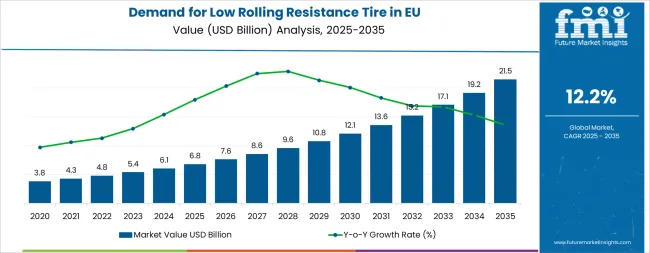
Between 2025 and 2030, EU low rolling resistance tire demand is projected to expand from USD 6.8 billion to USD 11.9 billion, resulting in a value increase of USD 5.1 billion, which represents 34.7% of the total forecast growth for the decade. This phase of development will be shaped by rising adoption of electric vehicles across European markets, increasing fuel efficiency regulations under EU Green Deal initiatives, and growing mainstream acceptance of low rolling resistance tires across passenger vehicle and commercial fleet segments. Manufacturers are expanding their product portfolios to address the evolving preferences for improved fuel efficiency, enhanced durability characteristics, and technologically advanced tire formulations comparable to conventional tire performance standards.
From 2030 to 2035, sales are forecast to grow from USD 11.9 billion to USD 21.5 billion, adding another USD 9.6 billion, which constitutes 65.3% of the ten-year expansion. This period is expected to be characterized by further expansion of electric vehicle integration, advancement of smart tire technologies incorporating real-time performance monitoring capabilities, and development of premium AI-optimized tire designs targeting high-performance automotive applications. The growing emphasis on environmental sustainability and increasing consumer willingness to pay premium prices for fuel-efficient alternatives will drive demand for innovative low rolling resistance tire products that deliver authentic fuel economy benefits and emission reduction advantages.
Between 2020 and 2025, EU low rolling resistance tire sales experienced robust expansion at a CAGR of 11.8%, growing from USD 3.8 billion to USD 6.8 billion. This period was driven by increasing environmental consciousness among European consumers, rising awareness of fuel efficiency benefits, and growing recognition of emission reduction advantages. The industry developed as major tire manufacturers and automotive OEMs recognized the commercial potential of fuel-efficient tire alternatives. Product innovations, improved compound formulations, and advanced tread pattern designs began establishing consumer confidence and mainstream acceptance of low rolling resistance tire products.
| Metric | Value |
|---|---|
| Market Size (2025) | USD 6.8 billion |
| Market Size (2035) | USD 21.5 billion |
| CAGR (2025-2035) | 12.2% |
Industry expansion is being supported by the rapid increase in environmental consciousness across European countries and the corresponding demand for sustainable, fuel-efficient, and cost-effective transportation solutions with proven performance in diverse driving applications. Modern European consumers rely on low rolling resistance tires as direct replacements for conventional tires in passenger vehicles, commercial fleets, and electric vehicle applications, driving demand for products that match or exceed conventional tire performance characteristics, including durability, wet grip performance, and handling capabilities. Even minor environmental concerns, such as fuel consumption reduction, emission management, or operational cost optimization, can drive comprehensive adoption of low rolling resistance tires to maintain optimal vehicle efficiency and support sustainable transportation patterns.
The growing awareness of climate change issues and increasing recognition of transportation's environmental impact are driving demand for low rolling resistance tire alternatives from certified manufacturers with appropriate sustainability credentials and advanced manufacturing practices. Regulatory authorities across EU member states are increasingly establishing clear guidelines for tire labeling standards, fuel efficiency requirements, and emission reduction targets to maintain consumer safety and ensure product consistency. Scientific research studies and performance analyses are providing evidence supporting low rolling resistance tires' fuel efficiency advantages and environmental improvements, requiring specialized manufacturing methods and standardized compound formulations for authentic fuel economy development, optimal rolling resistance reduction, and appropriate safety profiles, including wet grip performance and tread life optimization.
Sales are segmented by vehicle type, width type, sales channel, nature, and country. By vehicle type, demand is divided into passenger vehicle, light commercial vehicle, and heavy commercial vehicle. Based on width type, sales are categorized into dual type and wide band type. In terms of sales channel, demand is segmented into OEM and aftermarket. By nature, sales are classified into conventional and organic/sustainable. Regionally, demand is focused on Germany, France, Italy, Spain, the Netherlands, the United Kingdom, and the Rest of Europe.
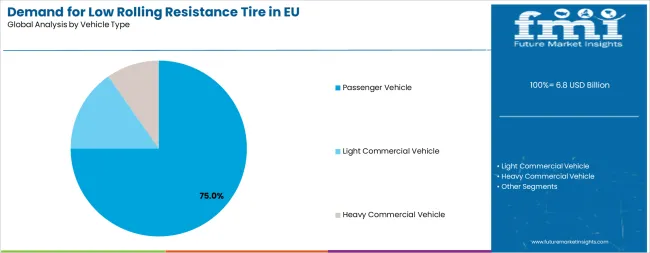
The passenger vehicle segment is projected to account for 75.0% of EU low rolling resistance tire sales in 2025, establishing itself as the dominant vehicle category across European markets. This commanding position is fundamentally supported by passenger vehicles' high production volumes across European automotive manufacturing hubs, comprehensive consumer focus on fuel efficiency, and regulatory requirements for emission reduction across EU member states. The passenger vehicle format delivers exceptional applicability, providing manufacturers with a substantial market opportunity that facilitates mass adoption, technology integration, and fuel economy improvement benefits essential for mainstream consumer acceptance.
This segment benefits from frequent urban and highway driving patterns where fuel economy improvements directly translate to consumer cost savings, well-established distribution infrastructure across European tire retail networks, and extensive availability through both OEM and aftermarket channels that maintain rigorous EU quality standards and performance certifications. The passenger vehicle applications offer versatility across various vehicle types, including sedans, SUVs, crossovers, and electric vehicles, supported by proven manufacturing technologies that address traditional challenges in fuel efficiency performance and durability characteristics.
The passenger vehicle segment is expected to maintain its 75.0% share through 2035, demonstrating stable positioning as electric vehicle adoption accelerates and fuel efficiency regulations tighten across European automotive markets throughout the forecast period.
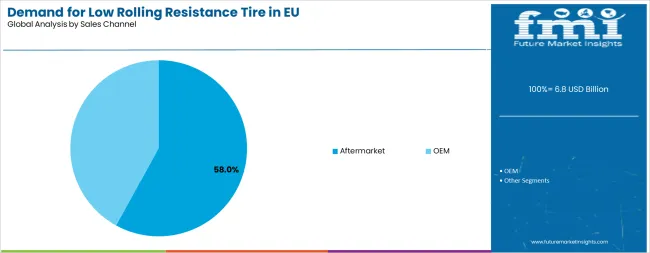
Aftermarket channel is positioned to represent 58.0% of total EU low rolling resistance tire demand across European markets in 2025, maintaining this substantial share through 2035, reflecting the segment's dominance as the primary distribution format within the industry ecosystem. This considerable share directly demonstrates that aftermarket represents the largest single sales channel, with consumers purchasing replacement low rolling resistance tires through tire retailers, automotive service centers, e-commerce platforms, and specialty tire outlets for tire replacement cycles, fleet maintenance applications, and upgrade installations mirroring traditional tire purchase behavior.
Modern European consumers increasingly view aftermarket low rolling resistance tires as accessible, cost-effective alternatives to OEM tire options, driving demand for products optimized for diverse vehicle applications with appropriate performance characteristics, pricing structures that appeal beyond premium automotive segments, and availability that maintains consumer accessibility and competitive market dynamics. The segment benefits from continuous product innovation focused on improved fuel efficiency performance, enhanced durability characteristics preventing premature wear, and advanced compound development eliminating performance compromises associated with early low rolling resistance tire formulations.
The segment's stable share reflects proportional growth across all sales channels, with aftermarket maintaining its leading position as the primary consumer-facing distribution format throughout the forecast period.
Wide band type tire configuration represents a significant and growing portion of EU low rolling resistance tire applications, particularly within passenger vehicle segments where single wide tires provide improved fuel efficiency through reduced rolling resistance and weight optimization. This width type proves essential for modern passenger vehicle applications, including electric vehicles, hybrid vehicles, and premium automotive segments requiring maximum fuel efficiency and aerodynamic performance under diverse European driving conditions.
The segment benefits from advanced automotive engineering trends favoring weight reduction, optimized tire contact patches, and improved vehicle dynamics supporting enhanced fuel efficiency throughout the forecast period. Wide band configurations enable automotive manufacturers to optimize vehicle efficiency across urban and highway applications while maintaining necessary handling characteristics and safety margins required for European road standards.
Manufacturers are developing specialized wide band formulations featuring enhanced fuel efficiency characteristics, improved tread life durability, and advanced compound technologies supporting passenger vehicle applications where operational cost reduction and environmental responsibility prove critical for consumer satisfaction and regulatory compliance.
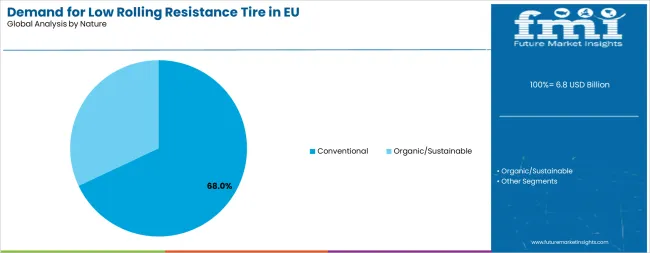
Conventional low rolling resistance tire products are strategically positioned to contribute 68.0% of total European sales in 2025, maintaining this substantial share through 2035, representing products produced through standard manufacturing methods without organic or premium sustainability certification requirements. These conventional products successfully deliver accessible pricing and consistent quality while ensuring broad commercial availability across all retail channels and automotive service operations that prioritize volume scalability and cost competitiveness over premium sustainability certification.
Conventional production serves price-conscious consumers, mainstream retail applications, and large-volume commercial operators, including logistics companies, fleet operators, and institutional vehicle services that require reliable supply at competitive price points. The segment derives significant competitive advantages from established ingredient supply chains, economies of scale in manufacturing, and the ability to meet substantial volume requirements from major European retailers and automotive distributors without organic certification constraints limiting sourcing options.
The segment's stable share through 2035 reflects the category's growth stage, where mainstream adoption and volume expansion take priority over premium sustainability differentiation, with conventional products commanding the majority position and continuing to grow proportionally with industry expansion.
EU low rolling resistance tire sales are advancing rapidly due to accelerating environmental consciousness, comprehensive EU emission regulations, and increasing fuel cost awareness driving consumer preference for fuel-efficient transportation solutions. The industry faces challenges, including higher manufacturing costs limiting price-sensitive market penetration, raw material price volatility affecting product pricing, and technology complexity requiring specialized manufacturing capabilities. Continued innovation in compound formulation technologies and smart tire integration remains central to industry development.
The rapidly accelerating development of EU environmental regulations is fundamentally transforming European automotive tire markets from conventional tire dominance to fuel-efficient tire adoption, enabling substantial emission reduction benefits previously unattainable through traditional tire formulations. Advanced regulatory frameworks featuring stringent fuel efficiency standards under the EU Green Deal and comprehensive emission reduction targets allow tire manufacturers to position low rolling resistance tires as essential compliance solutions delivering authentic environmental benefits through proven fuel consumption reduction. These regulatory developments prove particularly transformative for passenger vehicle applications, including urban transportation, highway driving, and commercial fleet operations, where fuel efficiency improvements prove essential for regulatory compliance and operational cost management.
Major European tire manufacturers invest heavily in regulatory compliance expertise, advanced testing capabilities, and certification processes for low rolling resistance tire products, recognizing that EU environmental standards represent critical market drivers for fuel-efficient tire adoption. Manufacturers collaborate with automotive OEMs, EU regulatory authorities, and industry organizations to develop standardized testing protocols that validate fuel efficiency performance while maintaining safety standards supporting consumer protection and product consistency.
Modern EU low rolling resistance tire producers systematically incorporate advanced sensor technologies, including tire pressure monitoring systems, temperature sensors, and performance analytics platforms that deliver real-time tire performance data, predictive maintenance capabilities, and optimal tire operation guidance, supporting fleet management, consumer safety, and vehicle efficiency applications. Strategic integration of smart technologies optimized for connected vehicle ecosystems enables manufacturers to position low rolling resistance tires as comprehensive vehicle efficiency solutions where performance monitoring directly determines operational optimization and maintenance efficiency.
Companies implement extensive technology development programs, automotive industry partnerships, and data analytics platforms targeting specific applications, including commercial fleet management requiring predictive maintenance, consumer vehicles benefiting from performance optimization, and logistics operations demanding maximum efficiency. Manufacturers leverage smart technology capabilities in marketing campaigns, OEM collaborations, and product differentiation strategies, positioning technology-enhanced low rolling resistance tires as advanced transportation solutions delivering measurable performance benefits.
European consumers increasingly prioritize sustainable manufacturing practices featuring renewable materials, reduced environmental impact, and circular economy principles that align with environmental responsibility and resource conservation philosophies. This sustainability trend enables manufacturers to differentiate premium offerings through sustainable sourcing strategies, recycled material integration, and end-of-life tire recycling programs that resonate with environmentally conscious European consumers seeking low rolling resistance alternatives without compromising environmental principles. Sustainable manufacturing positioning proves particularly important for premium automotive applications where environmental credentials require transparency supporting consumer trust and brand positioning.
The development of bio-based rubber compounds, recycled material integration technologies, and advanced manufacturing processes expands manufacturers' abilities to create sustainable products delivering authentic fuel efficiency characteristics without extensive environmental impact. Brands collaborate with European material suppliers, sustainability experts, and environmental organizations to develop products balancing sustainability requirements with performance needs, supporting marketing claims and premium positioning while maintaining fuel efficiency reliability and safety acceptability across mainstream European consumer segments.
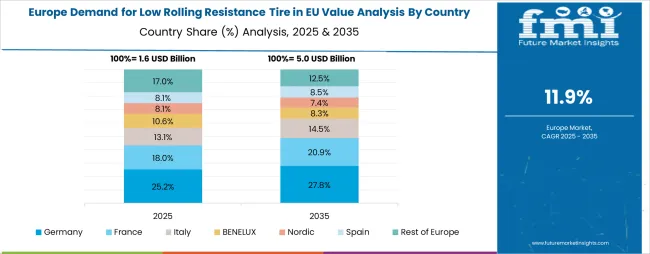
EU low rolling resistance tire sales are projected to grow from USD 6.8 billion in 2025 to USD 21.5 billion by 2035, registering a CAGR of 12.2% over the forecast period. The Rest of Europe region is expected to demonstrate the strongest growth trajectory with a 13.2% CAGR, supported by emerging market development, increasing retail penetration, and growing environmental consciousness. France and Italy follow with 13.6% and 13.1% CAGR each, attributed to stringent EU emission regulations and progressive urban consumer adoption, respectively.
Germany, while maintaining the largest share at 28.0% in 2025, is expected to grow at a 13.0% CAGR, reflecting market maturity and established automotive manufacturing infrastructure. The United Kingdom and Spain also demonstrate 11.7% and 12.4% CAGR, respectively, supported by net-zero transport commitments and expanding commercial fleet adoption.
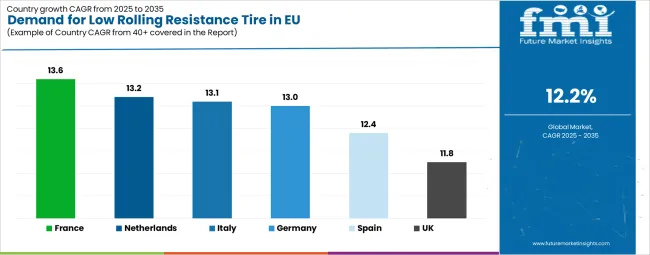
EU low rolling resistance (LRR) tire sales are projected to expand at a regional CAGR of 12.8% (2025–2035), underscoring strong momentum across Europe’s major automotive economies. France leads with the highest growth rate at 13.6%, supported by aggressive decarbonization policies and the phase-out of combustion engines, which accelerate adoption of fuel-efficient tires. The Netherlands follows closely at 13.2%, emphasizing sustainability leadership, advanced tire technology integration, and progressive mobility policies. Italy posts 13.1% CAGR, leveraging its urban markets, automotive heritage, and growing focus on sustainable mobility. Germany grows at 13.0%, maintaining the largest market share due to its OEM dominance, extensive supplier ecosystem, and premium vehicle production. Spain registers 12.4% growth, supported by its role as a major production base, tourism-driven transportation demand, and logistics modernization. The United Kingdom, while slightly lower at 11.7%, benefits from net-zero transport goals, corporate fleet decarbonization efforts, and rising sustainability mandates.
The low rolling resistance tire industry in Germany is projected to exhibit robust growth with a CAGR of 13.0% through 2035, driven by world-leading automotive manufacturing expertise, comprehensive OEM integration across premium vehicle segments, and strong commitment to environmental sustainability throughout the country. Germany's sophisticated automotive industry and internationally recognized leadership in engineering innovation are creating substantial demand for advanced low rolling resistance tire solutions across passenger vehicle, commercial vehicle, and electric vehicle applications.
Major automotive manufacturers, including Mercedes-Benz, BMW, Volkswagen Group, and Audi, collaborate extensively with tire suppliers including Continental AG, Bridgestone Europe, and Michelin to develop co-engineered tire solutions optimized for specific vehicle platforms. German demand benefits from high environmental consciousness supporting fuel-efficient transportation choices, substantial premium vehicle market enabling advanced tire technology adoption, and comprehensive logistics infrastructure requiring operational cost optimization across commercial fleet operations.
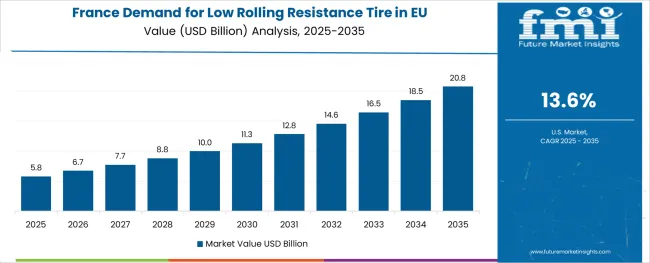
The low rolling resistance tire sector in France is expanding at a CAGR of 13.6%, substantially supported by comprehensive EU environmental regulations, national combustion engine phase-out commitments by 2040, and progressive urban transportation policies throughout major French cities. France's growing environmental consciousness among younger urban consumers and government support for electric vehicle adoption are systematically driving demand for fuel-efficient tire alternatives across passenger vehicle and commercial logistics segments.
Major tire manufacturers, including Michelin's extensive French operations, along with automotive retailers such as Carrefour, Auchan, Leclerc, and specialized fitment centers throughout Paris, Lyon, Marseille, and other metropolitan areas, systematically establish comprehensive low rolling resistance tire offerings to serve continuously growing demand. French sales particularly benefit from sophisticated automotive consumer preferences demanding superior quality standards, substantial premium vehicle market supporting advanced tire technology adoption, and extensive logistics sectors requiring fuel efficiency optimization. Consumer education initiatives and automotive industry partnerships significantly enhance penetration rates despite premium pricing compared to conventional tire alternatives.
The demand for low rolling resistance tire in Italy is growing at a robust CAGR of 13.1%, fundamentally driven by increasing environmental consciousness, progressive urban consumer segments, and gradual modernization of Italian transportation patterns to incorporate fuel-efficient alternatives. Italy's traditionally automotive-focused culture is gradually accommodating low rolling resistance tire options as consumers and fleet operators recognize fuel efficiency benefits and environmental advantages while maintaining vehicle performance standards.
Major tire distributors and automotive service centers, including Coop Italia, Esselunga, Conad operations, throughout Milan, Rome, Turin, and other major cities strategically invest in low rolling resistance tire category expansion and technical education programs to address growing interest in fuel-efficient alternatives. Italian sales particularly benefit from strong commercial vehicle presence creating natural demand for operational cost reduction solutions, premium automotive segment adoption in luxury vehicle applications through brands like Ferrari, Lamborghini, and Maserati, and increasing environmental awareness among younger urban demographics contributing to mainstream acceptance of fuel-efficient tire technologies.
Demand for low rolling resistance tire in Spain is projected to grow at a CAGR of 12.4%, substantially supported by commercial logistics sector expansion, tourism industry exposure to sustainable transportation practices, and expanding retail availability through major tire distributors and automotive service networks. Spanish transportation sector's emphasis on operational efficiency positions fuel-efficient tire solutions as attractive alternatives supporting fleet profitability and environmental compliance.
Major tire retailers and automotive service chains, including Mercadona, Carrefour España, Alcampo, and Lidl España operations, throughout Madrid, Barcelona, Valencia, and coastal commercial centers systematically expand low rolling resistance tire offerings, with commercial fleet operators proving particularly receptive to fuel efficiency benefits supporting total cost of ownership optimization. Spain's substantial tourism industry exposes domestic consumers and fleet operators to international sustainability standards through hotel transportation fleets, rental vehicle services, and international logistics operations, normalizing fuel-efficient alternatives and encouraging adoption among cost-conscious commercial operators.
Demand for low rolling resistance tire in the Netherlands is expanding at a CAGR of 13.2%, fundamentally driven by exceptionally strong environmental consciousness, leadership in sustainable transportation innovation, and comprehensive commercial fleet support for fuel-efficient technologies across mainstream distribution channels. Dutch consumers and fleet operators demonstrate particularly high receptivity to sustainability messaging and willingness to adopt fuel-efficient technologies reducing environmental impact.
Netherlands sales significantly benefit from well-developed automotive retail infrastructure, including Albert Heijn's automotive sections, Ekoplaza's specialized organic stores, specialized tire retailers, automotive service centers, and commercial fleet procurement networks supporting comprehensive product availability across passenger vehicle and commercial applications. The country's logistics industry concentration, including extensive port operations and European distribution networks based in Rotterdam and Amsterdam regions, creates substantial commercial demand for fuel-efficient tire solutions optimizing operational costs. The Netherlands also serves as innovation testing ground for European tire manufacturers, with successful Dutch product launches often expanding to broader European markets.
The low rolling resistance tire industry in the United Kingdom is expected to grow at a CAGR of 11.7% from 2025 to 2035, reflecting steady progress under national net-zero transport commitments by 2050 and comprehensive tire labeling standards. UK adoption concentrates throughout metropolitan centers including London, Manchester, Birmingham, and Edinburgh where electric vehicle penetration, low-emission zone requirements including London's Ultra Low Emission Zone (ULEZ), and corporate sustainability targets prove most advanced throughout commercial fleet and passenger vehicle segments.
Major tire retailers, including Kwik Fit, National Tyres and Autocare, Halfords, and manufacturer-operated fitment centers, strategically invest in low rolling resistance tire category expansion and consumer education programs addressing growing interest in fuel-efficient tire alternatives. UK sales particularly benefit from professional fleet operator requirements meeting emissions reporting standards, tire labeling transparency enabling informed consumer choices, and mixed urban-motorway driving profiles creating natural demand for fuel-efficient tire solutions maintaining wet-grip performance demanded by maritime climate conditions.
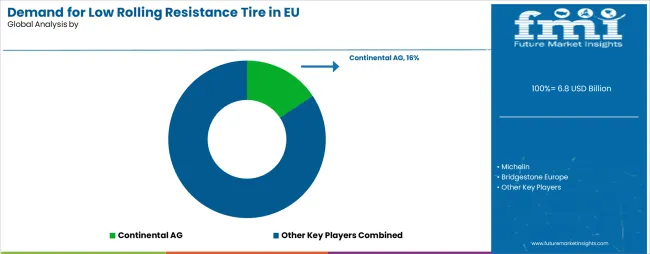
EU low rolling resistance tire sales are defined by competition among multinational tire manufacturers, European automotive technology providers, and regional specialists. Companies are investing in advanced compound formulation technologies, smart tire integration capabilities, sustainable manufacturing processes, and performance optimization research to deliver high-quality, functionally superior, and environmentally responsible low rolling resistance tire solutions. Strategic partnerships with European automotive OEMs, aftermarket expansion initiatives, and marketing campaigns emphasizing fuel efficiency improvements and environmental benefits are central to strengthening competitive positioning.
Major participants include Continental AG with an estimated 16.0% share, leveraging its comprehensive European R&D capabilities, extensive manufacturing infrastructure across Germany and other EU countries, and established automotive OEM relationships supporting consistent market leadership. Continental benefits from extensive product portfolio, technical support services, and ability to provide application-specific solutions, including passenger vehicle tires, commercial vehicle tires, and electric vehicle-optimized formulations supporting diverse automotive applications.
Michelin holds approximately 15.0% share, emphasizing cutting-edge compound technologies, smart tire system integration through partnerships, and premium automotive segment focus driving brand recognition and consumer preference throughout European markets. Michelin's success in developing products with superior fuel efficiency characteristics, advanced durability profiles, and innovative performance features creates strong competitive positioning and mainstream market acceptance, supported by comprehensive distribution networks across France and broader European operations.
Bridgestone Europe accounts for roughly 12.0% share through its position as a leading tire manufacturer, providing advanced low rolling resistance solutions, innovative compound formulations, and comprehensive technical support helping European automotive manufacturers optimize tire performance for specific vehicle platforms and regulatory requirements.
Pirelli & C S.p.A represents approximately 8.0% share, supporting growth through premium positioning, luxury automotive segment focus using advanced manufacturing at Italian facilities, and high-performance tire solutions. Pirelli leverages motorsport heritage, brand prestige, and technical expertise, attracting premium-focused European consumers seeking authentic performance alternatives with sophisticated engineering.
Other companies including The Goodyear Tire & Rubber Company (Europe operations), Hankook Tire Europe, Nokian Tyres, Apollo Vredestein, Maxxis International, and numerous regional brands collectively hold 49.0% share, reflecting the competitive nature of European low rolling resistance tire industries, where numerous national brands, private label offerings from major retailers, specialized manufacturers, and emerging technology companies serve local markets, specific vehicle segments, and niche applications. This competitive landscape provides opportunities for differentiation through specialized applications (commercial fleet, electric vehicle, premium passenger), innovative production technologies (AI-powered design, sustainable materials), regional manufacturing capabilities, and premium positioning resonating with environmentally conscious European consumers seeking authentic fuel efficiency alternatives.
| Item | Value |
|---|---|
| Quantitative Units | USD 21.5 billion |
| Vehicle Type | Passenger Vehicle, Light Commercial Vehicle, Heavy Commercial Vehicle |
| Width Type | Dual Type, Wide Band Type |
| Sales Channel | OEM, Aftermarket |
| Nature | Conventional, Organic/Sustainable |
| Forecast Period | 2025-2035 |
| Base Year | 2025 |
| Historical Data | 2020-2024 |
| Countries Covered | Germany, France, Italy, Spain, the Netherlands, United Kingdom, and the Rest of Europe |
| Key Companies Profiled | Continental AG, Michelin, Bridgestone Europe, Pirelli & C S.p.A, The Goodyear Tire & Rubber Company (Europe), Hankook Tire Europe, Nokian Tyres, Apollo Vredestein, Maxxis International, Sumitomo Rubber Industries (Europe), Regional European brands |
| Report Pages | 280+ Pages |
| Data Tables | 45+ Tables and Figures |
| Additional Attributes | Dollar sales by vehicle type, width type, sales channel, and nature; regional demand trends across major European markets; competitive landscape analysis with established European tire manufacturers and emerging technology providers; consumer preferences for fuel efficiency and environmental sustainability; integration with electric vehicle platforms and smart tire technologies; innovations in compound formulation optimization and performance enhancement; adoption across passenger vehicle, commercial fleet, and premium automotive applications; EU regulatory framework analysis for fuel efficiency standards and emission reduction targets; supply chain strategies; and penetration analysis for mainstream and environmentally conscious European consumers. |
The global demand for low rolling resistance tire in EU is estimated to be valued at USD 6.8 billion in 2025.
The market size for the demand for low rolling resistance tire in EU is projected to reach USD 21.5 billion by 2035.
The demand for low rolling resistance tire in EU is expected to grow at a 12.2% CAGR between 2025 and 2035.
The key product types in demand for low rolling resistance tire in EU are passenger vehicle, light commercial vehicle and heavy commercial vehicle.
In terms of nature, conventional segment to command 68.0% share in the demand for low rolling resistance tire in EU in 2025.






Our Research Products

The "Full Research Suite" delivers actionable market intel, deep dives on markets or technologies, so clients act faster, cut risk, and unlock growth.

The Leaderboard benchmarks and ranks top vendors, classifying them as Established Leaders, Leading Challengers, or Disruptors & Challengers.

Locates where complements amplify value and substitutes erode it, forecasting net impact by horizon

We deliver granular, decision-grade intel: market sizing, 5-year forecasts, pricing, adoption, usage, revenue, and operational KPIs—plus competitor tracking, regulation, and value chains—across 60 countries broadly.

Spot the shifts before they hit your P&L. We track inflection points, adoption curves, pricing moves, and ecosystem plays to show where demand is heading, why it is changing, and what to do next across high-growth markets and disruptive tech

Real-time reads of user behavior. We track shifting priorities, perceptions of today’s and next-gen services, and provider experience, then pace how fast tech moves from trial to adoption, blending buyer, consumer, and channel inputs with social signals (#WhySwitch, #UX).

Partner with our analyst team to build a custom report designed around your business priorities. From analysing market trends to assessing competitors or crafting bespoke datasets, we tailor insights to your needs.
Supplier Intelligence
Discovery & Profiling
Capacity & Footprint
Performance & Risk
Compliance & Governance
Commercial Readiness
Who Supplies Whom
Scorecards & Shortlists
Playbooks & Docs
Category Intelligence
Definition & Scope
Demand & Use Cases
Cost Drivers
Market Structure
Supply Chain Map
Trade & Policy
Operating Norms
Deliverables
Buyer Intelligence
Account Basics
Spend & Scope
Procurement Model
Vendor Requirements
Terms & Policies
Entry Strategy
Pain Points & Triggers
Outputs
Pricing Analysis
Benchmarks
Trends
Should-Cost
Indexation
Landed Cost
Commercial Terms
Deliverables
Brand Analysis
Positioning & Value Prop
Share & Presence
Customer Evidence
Go-to-Market
Digital & Reputation
Compliance & Trust
KPIs & Gaps
Outputs
Full Research Suite comprises of:
Market outlook & trends analysis
Interviews & case studies
Strategic recommendations
Vendor profiles & capabilities analysis
5-year forecasts
8 regions and 60+ country-level data splits
Market segment data splits
12 months of continuous data updates
DELIVERED AS:
PDF EXCEL ONLINE
Demand Signal Repository Solutions Market Size and Share Forecast Outlook 2025 to 2035
Demand Side Management Market Size and Share Forecast Outlook 2025 to 2035
Demand Response Market Analysis - Size, Share, and Forecast Outlook 2025 to 2035
North America Shipping Supplies Market Trends – Innovations & Growth 2024-2034
Demand of Kozani Saffron in Greece Analysis - Size, Share & Forecast 2025 to 2035
Demand of No-acid Whey Strained Dairy Processing Concepts in European Union Size and Share Forecast Outlook 2025 to 2035
Demand for Bronte Pistachio in Italy Analysis - Size, Share & Forecast 2025 to 2035
Demand and Trend Analysis of Gaming Monitor in Japan Size and Share Forecast Outlook 2025 to 2035
Demand and Trend Analysis of Gaming Monitor in Korea Size and Share Forecast Outlook 2025 to 2035
Demand and Trend Analysis of Gaming Monitor in Western Europe Size and Share Forecast Outlook 2025 to 2035
Glycine Soja (Soybean) Seed Extract Market Size and Share Forecast Outlook 2025 to 2035
Demand and Trend Analysis of Yeast in Japan - Size, Share, and Forecast Outlook 2025 to 2035
Demand and Trends Analysis of Stevia in Japan Size and Share Forecast Outlook 2025 to 2035
Demand of Pistachio-based desserts & ingredients in France Analysis - Size, Share & Forecast 2025 to 2035
Japan Women’s Intimate Care Market Trends – Growth & Forecast 2024-2034
Western Europe Men’s Skincare Market Analysis – Forecast 2023-2033
Demand and Trend Analysis of Fabric Stain Remover in Korea Size and Share Forecast Outlook 2025 to 2035
Demand and Sales Analysis of Paper Cup in Japan Size and Share Forecast Outlook 2025 to 2035
Demand and Sales Analysis of Paper Cup in Korea Size and Share Forecast Outlook 2025 to 2035
Demand of MFGM-enriched Powders & RTDs in European Union Size and Share Forecast Outlook 2025 to 2035

Thank you!
You will receive an email from our Business Development Manager. Please be sure to check your SPAM/JUNK folder too.
Chat With
MaRIA